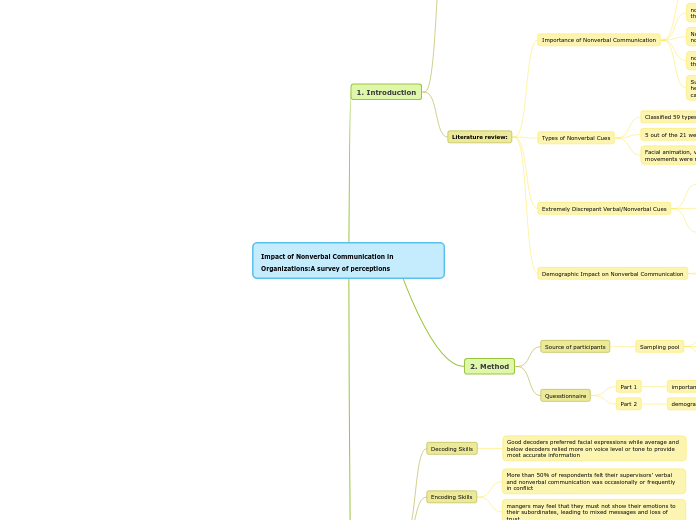Impact of Nonverbal Communication in Organizations:A survey of perceptions
Introduction
Objectives:
gather information on the importance of
non-verbal feedback and ability to decode
non-verbal cues.
to compare those findings with the
existing body of literature on non-verbal communication
Use these finding to improve non-verbal
communication in business.
Literature review:
Importance of Nonverbal Communication
non-verbal channels contributes to 93 percent of the attitudinal message to the receiver
not sum total but rather, blending of one channel with another that contributes most to the total impact of the message.
Non verbal channels like voice tone have a stronger impact on non decoders.
nonverbal behaviors can be used to predict truth or deceit in the sender
Successful candidates in job interviews had more eye contact, head movement and smiling compared to unsuccessful candidates
Types of Nonverbal Cues
Classified 59 types of nonverbal behaviour into 21 groups
5 out of the 21 were significantly involved in conversation
Facial animation, vocal warmth, vocal pitch and body movements were most important
Extremely Discrepant Verbal/Nonverbal Cues
Research shows that vocal channels cant be manipulated to suppress true feelings, compared to facial features.
when there is extreme disconnect between vocal and facial cues the decoder suspects the sender is lying
However, facial cues give more information in honest communication
Demographic Impact on Nonverbal Communication
Gender has the greatest effect on decoding non-verbal
communication
women were more accurate in reading non deceptive communication compared to deceptive communication.
Method
Source of participants
Sampling pool
505 surverys
217 males and 288 females
67% was between the ages of 25 and 45.
Quesstionnaire
Part 1
importance and the ability to decode
Part 2
demographic information of participants
Results
Decoding Skills
Good decoders preferred facial expressions while average and below decoders relied more on voice level or tone to provide most accurate information
Encoding Skills
More than 50% of respondents felt their supervisors’ verbal and nonverbal communication was occasionally or frequently in conflict
mangers may feel that they must not show their emotions to their subordinates, leading to mixed messages and loss of trust
Gender Differences
Female decoders favoured non verbal cues compared to verbal cues.
Predicting Nonverbal Skills
Women in the educational industry rated themselves as the best decoder, compared to any other professions.
This is understandable, as women in other studies are good decoders. Teaching requires intense, long periods of communication from the teacher to ensure students are following.
Perception Differences in Managers and Employees
Management employees believed that decoding ability improved with age.
